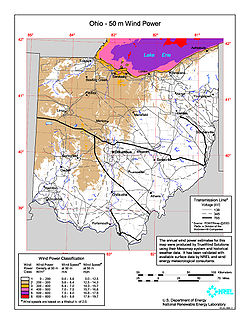
Wind power in Ohio has a long history. As of 2016, Ohio had 545 megawatts (MW) of utility-scale wind power installations, responsible for generating 1.1% of the state's electricity. [1] Over 1000 MW more were under construction or pending approval. [2] Some installations have become tourist attractions. [3] [4] There has been a sudden increase in generating capacity, as the total wind power capacity in the state was just 9.7 MW in 2010. [5]
Contents
- History
- Brush's windmill dynamo
- NASA Lewis MOD series
- Wind turbine regulation
- Installed capacity and wind resources
- Wind farms
- American Municipal Power Inc Wind Farm
- Great Lakes Science Center
- One Energy Wind for Industry projects
- Wind generation
- See also
- References
- External links
Ohio's first large wind farm, Timber Road II near Payne in northwest Ohio, opened on October 6, 2011. [6] [7] It was surpassed in June 2012 by the 304 MW Blue Creek Wind Farm. [8] By 2019, there were 738 MW of capacity, which generated 1.71% of Ohio's electricity. [9]














